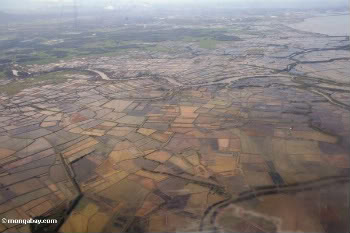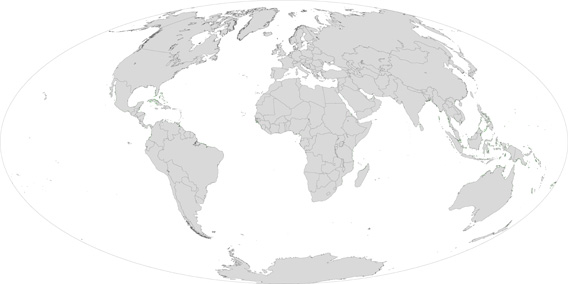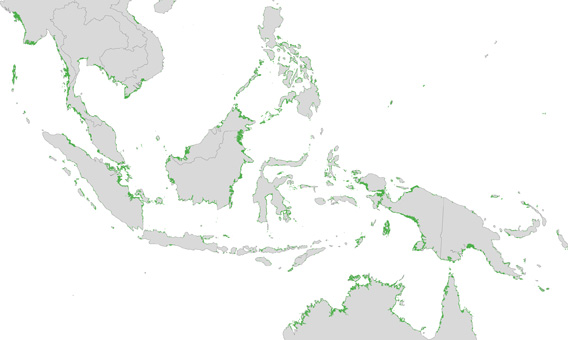Mangroves may be the world’s most carbon rich forests, according to a new study in Nature Geoscience. Measuring the carbon stored in 25 mangrove forests in the Indo-Pacific region, researchers found that mangroves forests stored up to four times as much carbon as other tropical forests, including rainforests.
“Mangroves have long been known as extremely productive ecosystems that cycle carbon quickly, but until now there had been no estimate of how much carbon resides in these systems. That’s essential information because when land-use change occurs, much of that standing carbon stock can be released to the atmosphere,” explains co-author Daniel Donato, a postdoctoral research ecologist at the Pacific Southwest Research Station in Hilo, Hawaii.
But how do mangroves, which are tropical coastal forests that are adapted to saline-conditions, store so much more carbon? The secret, say the researchers, is in the soil. Mangroves grow in deep soils that are on average five times larger than other forests soils in the tropics, as well as in temperate and boreal regions. Tidal water buries organic and inorganic material in this soil, which due to low-oxygen conditions, stores carbon more efficiently than other forest soils.
 Mangroves replaced by rice fields in Sulawesi, Indonesia. Photo by: Rhett A. Butler. |
“When we did the math, we were surprised to see just how much carbon is likely being released from mangrove clearing,” says Donato.
The findings make mangroves key to the global fight against climate change and, according to the study, should push policymakers to consider mangrove conservation in climate change agreements.
Beyond carbon
Mangroves provide a number of other ecosystems benefits beyond carbon sequestration. The coastal forests serve as nurseries for a variety marine fish, underpinning global fisheries and providing additional food for coastal communities.
In addition, recent studies have found that mangroves buffer human populations and property against tropical storms. During the devastating 2004 tsunami in Southeast Asia, regions with mangroves suffered less damage than those without.
Prior to today’s study regarding carbon sequestration, it estimated that mangroves provide at least $1.6 billion in ecosystem services annually. Yet despite their importance, mangroves are being felled at stunning rates.
An imperiled forest
According to a recent satellite analysis, 35% of the world’s mangroves were destroyed in 20 years, from 1980 to 2000. Around 50% of the world’s mangroves have likely vanished in the last half-century. Mangroves are being lost to a variety of impacts, including coastal developments; agriculture and aquaculture, such as shrimp farms and rice fields; and rising sea levels due to climate change.
“Mangroves are being destroyed at an alarming rate. This needs to stop. Our research shows that mangroves play a key role in climate change mitigation strategies,” said Daniel Murdiyarso, Senior Scientist at The Center for International Forestry Research (CIFOR), a co-author of the paper on mangroves and carbon sequestration.
According to the study mangroves account for 10% of the world’s carbon emissions due to deforestation, even though they make up less than 1% of the world’s forests.
“There is a lack of awareness of the full implications of mangrove loss for humankind,” Murdiyarso adds. “There is an urgent need for governments to acknowledge their importance and develop better policies to ensure their protection.”
Currently, less than 7% of the world’s mangroves are under legal protection.
CITATION: Donato, D. C. et al. Nature Geoscience advance online publication doi:10.1038/ngeo1123 (2011).

Global extent of mangrove ecosystems. Image courtesy of NASA and the US Geological Society. Click to enlarge.

Extent of mangroves in Southeast Asia. Image courtesy of NASA and the US Geological Society. Click to enlarge.
Related articles
NASA images reveal disappearing mangroves worldwide
(12/01/2010) In August, NASA and the US Geological Survey released the first-ever satellite analysis of the world’s mangrove ecosystems. What they found was dire: mangroves covered 12.3% less area than previously estimated. Now, NASA has released images of the world’s mangrove ecosystems (see below), which currently cover 137,760 square kilometers. Yet this number keeps shrinking: mangroves are vanishing rapidly due to rising sea levels, deforestation for coastal developments, agriculture and aquaculture.
Slight rise in mangrove forests in Eastern India
(11/29/2010) While mangrove forests are vanishing around the world, the Indian Ministry of Environment and Forests is reporting a slight uptick of mangrove forests along the nation’s eastern coast. According to a report, mangroves expanded from 4,581 square kilometers in 2005 to 4,639 square kilometers in 2007, an increase of 58 square kilometers.
Satellites show mangrove forest loss even worse than estimated

(08/19/2010) New satellite data shows that human actions are wiping out mangrove forests even faster than previous bleak estimates. Conducted by the US Geological Survey and NASA, the researchers found that mangroves comprise 12.3 percent less area than previously estimated. In total, satellites reveal that mangrove forests cover approximately 53,290 square miles (137,760 square kilometers). “Our assessment shows, for the first time, the exact extent and distribution of mangrove forests of the world at 30 meters spatial resolution, the highest resolution ever,” said Dr Chandra Giri from USGS.